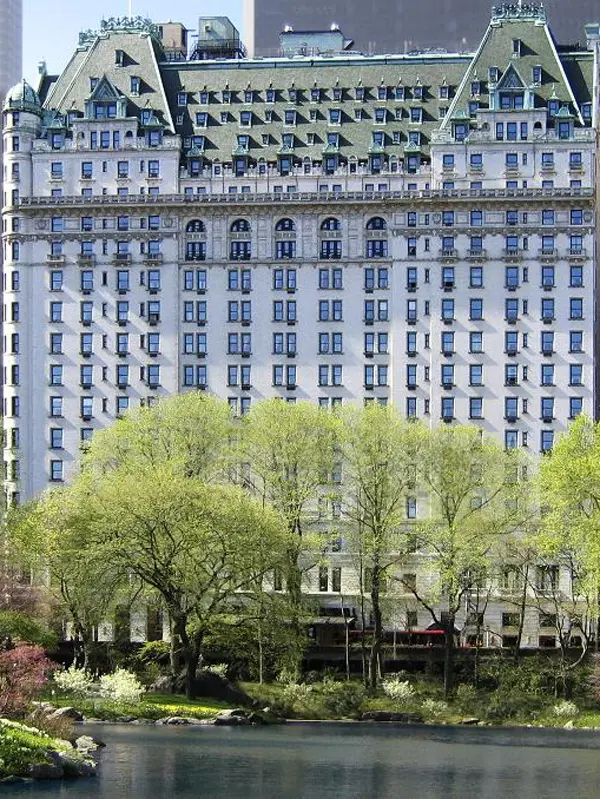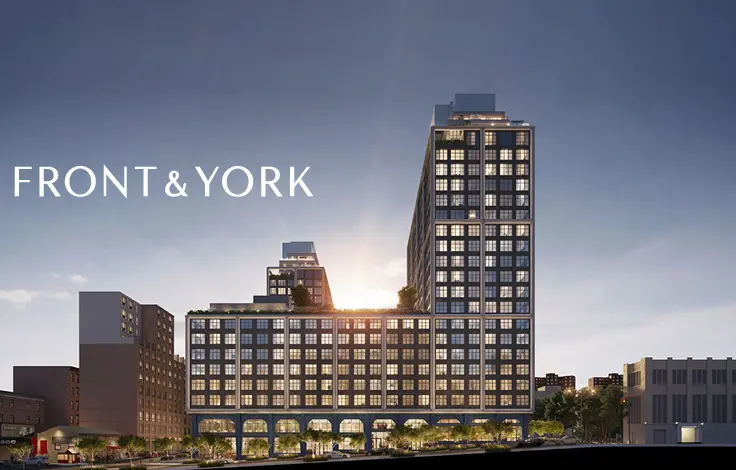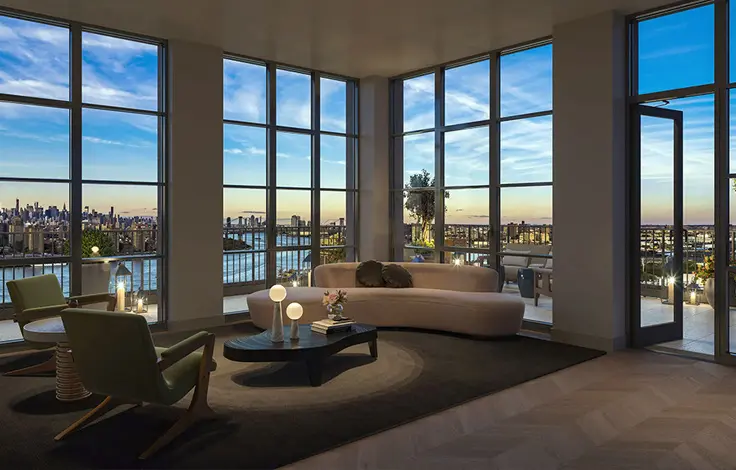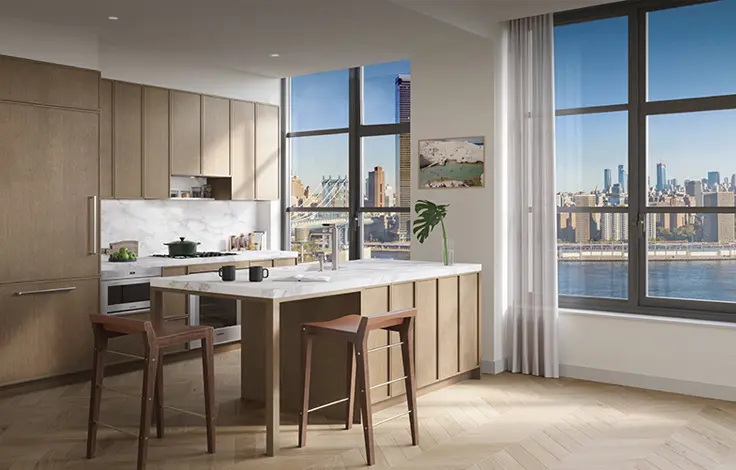The Plaza, 1 Central Park South: Review and Ratings
between 58th Street & Central Park South View Full Building Profile


The French Renaissance chateau-style building was designed by Henry Janeway Hardenbergh, who also designed the Dakota at 1 West 72nd Street. The Plaza opened to the public on October 1, 1907 as a luxury hotel.
The address of the Plaza is 768 Fifth Avenue and 1 Central Park South.
The hotel was closed for about two years when it was purchased by El Ad Properties for partial conversion to residential condominiums. The significantly restructured Plaza reopened on March 1, 2008 with 181 condominium apartments and 282 hotel units/keyrooms.
The condominium apartments, known as “private residences," at The Plaza have their own entrance on Central Park South and many face a large garden court with a cascading fountain at the bottom of the building’s large rectangular lightwell that is over its famous Palm Court restaurant.
Bottom Line
You’ll be “putting on the Ritz” with the “swells” and Russian billionaires when you sashay into the large, glamorous marble lobby on Central Park South.
For those who enjoy luxury and legend – and being steps from Central Park – The Plaza is “simply irresistible.”
Upstairs, many of the views are stunning and dramatic: Central Park to the north, the Pulitzer Fountain and the Apple Store in the plaza of the General Motors Building to the east, and Bergdorf Goodman to the south.
Description
The very impressive building has turreted corners and a mansard roof with finials – decorative architect elements atop gables – and flagpoles.
The white-brick building has a white marble base and very ornate entrance marquees with brass light stanchions and carpeted steps.
The entrance facing the Pulitzer Fountain and Fifth Avenue has five flagpoles above its marquee, one of which usually signifies the country of a foreign dignitary staying at the hotel.
One of the flags often honors Eloise, the impish little girl created in the 1950s by Kay Thompson, the entertainer and writer. Eloise, the hotel’s fictional “princess,” is depicted in a large painting near the hotel’s central Palm Court.
Amenities
The building has 24-hour doorman and concierge service as well as nanny service, limousine service, turn-down service, a private butler, beauty and wellness facilities, restaurants and a food hall.
The private residences have their own European-inspired garden with a cascading water feature and private terraces and “Juliet” balconies overlook the garden.
Apartments
The condominium "residences" are all on the north and east sides of the building and the hotel rooms are on the south side along 58th Street.
All homes have high ceilings with period moldings and mantelpieces. Floors are walnut-bordered herringbone parquet and were designed to reflect original mosaic patterns found in the Plaza’s lobbies. In some units, fittings in the baths have the “Double P” insignia and all are crafted by Kohler and Lefroy Brooks.
Kitchens contain Nero Marquina stone countertops and mosaic Calacatta marble-tiled backsplashes.
The 181 private residence condos have a separate entrance on Central Park South.
There are about 100 different apartment layouts ranging from small studios to large triplex penthouses.
Given the variety of floorplans, there is something for everyone.
Many of the units have corner windows in the building’s turrets. Some have terraces. Many have exceptional views of Central Park and upper Fifth Avenue and the horse-drawn carriages in Grand Army Plaza on the northwest corner of Fifth Avenue at 59th Street.
One of the penthouses triplexes has a double-height, skylit kitchen and an 80-foot-long entertaining suite with fireplace overlooking Central Park.
A three-bedroom apartment has a large foyer that leads into a huge dining room with two windows facing the park and also to a living room with a three-windowed semi-circular “nook” in one of the building’s turrets.
Another apartment has an entrance foyer that leads to a center hall that leads to a smaller hall entry to the 24-foot square living room with three-windowed corner turret adjacent to a good-sized library, and to another small hall entry to the master bedroom.
History
Generations of New Yorkers have cherished the hotel as the embodiment of the city’s elegance and sophistication: sipping cocktails surrounded by large paintings by Everett Shinn of horse-drawn carriages while overlooking Central Park in the Oak Bar as Cary Grant did in the beginning of Alfred Hitchcock’s classic film, “North by Northwest”; ordering Zombies in Trader Vic’s, the huge Polynesian restaurant, long since closed, in the basement; and attending Truman Capote’s “Black-and-White Ball” on November 28, 1966 for Katherine Graham, the publisher of the Washington Post.
The Capote event, held in the small but very impressive grand ballroom, was attended by 400 of the city’s most social personages and attendance was considered the definitive “having made it.”
When the famous hotel expanded to the west in 1921, the addition, designed by Warren & Wetmore, blocked the natural light hitting the skylight above the Palm Court that faces the Fifth Avenue entrance. The skylight was removed a generation later because of blackout concerns for air raids. A new Palm Court skylight, installed during the 2008 renovation and restructuring, utilizes artificial lights.
Conrad Hilton bought the Plaza for $7.4 million in 1943 and spent another $6 million on refurbishing.
The Childs Company, a national restaurant chain that partnered in the development of the neighboring Savoy-Plaza Hotel, (now the site of the General Motors Building), purchased the Plaza Hotel in 1955 for shares of its common stock, then valued at about $6,325,000. Childs would change its name to Hotel Corporation of America, now known as Sonesta International Hotels Corporation.
The Beatles stayed at the Plaza during their first visit to the United States in February 1964.
In 1988, Donald Trump bought the Plaza for $407.5 million following his divorce from his wife, Ivana Trump, the hotel’s president. Mr. Trump later sold the hotel in 1995 for $325 million to Troy Richard Campbell, who in 2004 sold it for $675 million to El Ad Properties.
The hotel's exterior was designated a city landmark in the 1969 and eight of its public rooms were declared interior landmarks when El Ad Properties bought the Plaza.
The city's landmarks commission approved the restoration plans that included new fiberglass finials, a new 21st floor and small additions facing the courtyard on the 19th and 20th floors. El Ad also agreed to reduce the number of condominiums it would create and to restore many of the building's spectacular interiors including the Palm Court, where it replaced the ceiling with a leaded-glass lay light to recall the original.
El Ad closed The Plaza on April 30, 2005, for extensive renovations.
At its centennial in 2007, fireworks were set off in many of its windows as the hotel was still closed, and guests sipped champagne splits with straws on Grand Army Plaza. The building reopened in 2008.
The building is now managed by Fairmont Hotels and Resorts.
Costas Kondylis & Partners LLP was the architect of record for the conversion and Gal Nauer did the interiors.
His Royal Highness Prince Alwaleed Bin Talal Abdulaziz Alsaud of Saudi Arabia owns an indirect 49.9% interest in the transient hotel and an indirect 25 percent ownership of the condo hotel shares, according to the El Ad Group Ltd. offering plan for the condominium apartments.
Of the 282 hotel units, 152, on floors 11 through 21, could be sold as “hotel-condos” in which purchasers own part of the condominium entity and have the right to stay for up to four months a year in one of the units, all of which are sold fully furnished. The 130 transient hotel rooms are on floors 4 through 10.
Each of the 152 Hotel Residences at the Plaza was available for purchase by individual private buyers who can stay at their hotel condominium residence for up to 120 days a year. Other times, the residence will be offered to hotel guests (or be rented out by individual owners), generating income for the condominium owners. The owner receives 95 percent of the revenue from the rental program, while the manager receives a 5% management fee.
Celebrities
The hotel was the setting for “Plaza Suite,” the play and film, and such movies as “The Way We Were,” “Barefoot in the Park,” “Funny Girl,” “Arthur,” “Scent of a Woman” and “Sleepless in Seattle.”
For many years, its large nightclub, The Persian Room, featured major entertainers such as Peggy Lee, Eartha Kitt and Liza Minnelli.






 6sqft delivers the latest on real estate, architecture, and design, straight from New York City.
6sqft delivers the latest on real estate, architecture, and design, straight from New York City.
